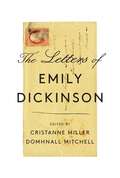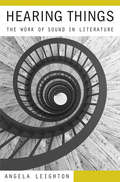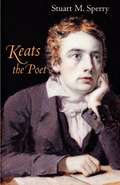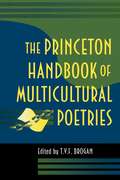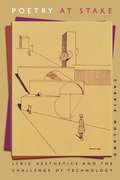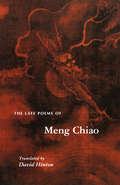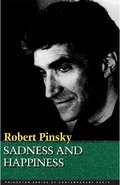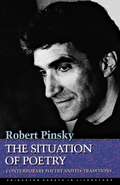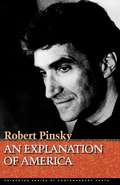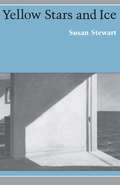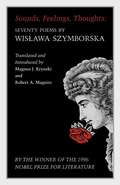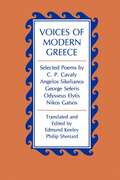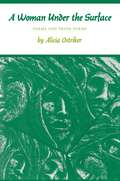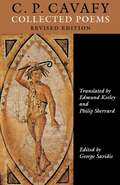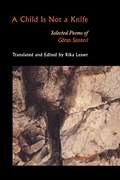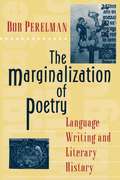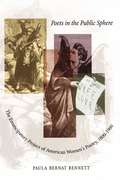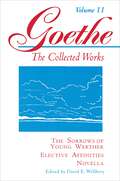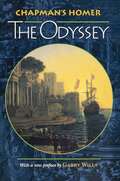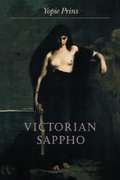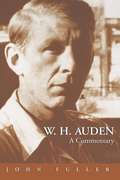- Table View
- List View
The Letters of Emily Dickinson
by Emily DickinsonThe definitive edition of Emily Dickinson’s correspondence, expanded and revised for the first time in over sixty years.Emily Dickinson was a letter writer before she was a poet. And it was through letters that she shared prose reflections—alternately humorous, provocative, affectionate, and philosophical—with her extensive community. While her letters often contain poems, and some letters consist entirely of a single poem, they also constitute a rich genre all their own. Through her correspondence, Dickinson appears in her many facets as a reader, writer, and thinker; social commentator and comedian; friend, neighbor, sister, and daughter.The Letters of Emily Dickinson is the first collected edition of the poet’s correspondence since 1958. It presents all 1,304 of her extant letters, along with the small number available from her correspondents. Almost 300 are previously uncollected, including letters published after 1958, letters more recently discovered in manuscript, and more than 200 “letter-poems” that Dickinson sent to correspondents without accompanying prose. This edition also redates much of her correspondence, relying on records of Amherst weather patterns, historical events, and details about flora and fauna to locate the letters more precisely in time. Finally, updated annotations place Dickinson’s writing more firmly in relation to national and international events, as well as the rhythms of daily life in her hometown. What emerges is not the reclusive Dickinson of legend but a poet firmly embedded in the political and literary currents of her time.Dickinson’s letters shed light on the soaring and capacious mind of a great American poet and her vast world of relationships. This edition presents her correspondence anew, in all its complexity and brilliance.
Hearing Things: The Work of Sound in Literature
by Angela LeightonHearing Things is a meditation on sound’s work in literature. Drawing on critical works and the commentaries of many poets and novelists who have paid close attention to the role of the ear in writing and reading, Angela Leighton offers a reconsideration of literature itself as an exercise in hearing. An established critic and poet, Leighton explains how we listen to the printed word, while showing how writers use the expressivity of sound on the silent page. Although her focus is largely on poets—Alfred Tennyson, W. B. Yeats, Robert Frost, Walter de la Mare, Wallace Stevens, Elizabeth Bishop, Jorie Graham, and Alice Oswald—Leighton’s scope includes novels, letters, and philosophical writings as well. Her argument is grounded in the specificity of the text under discussion, but one important message emerges from the whole: literature by its very nature commands listening, and listening is a form of understanding that has often been overlooked. Hearing Things offers a renewed call for the kind of criticism that, avoiding the programmatic or purely ideological, remains alert to the work of sound in every literary text.
Hearing Things: The Work of Sound in Literature
by Angela LeightonHearing Things is a meditation on sound’s work in literature. Drawing on critical works and the commentaries of many poets and novelists who have paid close attention to the role of the ear in writing and reading, Angela Leighton offers a reconsideration of literature itself as an exercise in hearing. An established critic and poet, Leighton explains how we listen to the printed word, while showing how writers use the expressivity of sound on the silent page. Although her focus is largely on poets—Alfred Tennyson, W. B. Yeats, Robert Frost, Walter de la Mare, Wallace Stevens, Elizabeth Bishop, Jorie Graham, and Alice Oswald—Leighton’s scope includes novels, letters, and philosophical writings as well. Her argument is grounded in the specificity of the text under discussion, but one important message emerges from the whole: literature by its very nature commands listening, and listening is a form of understanding that has often been overlooked. Hearing Things offers a renewed call for the kind of criticism that, avoiding the programmatic or purely ideological, remains alert to the work of sound in every literary text.
Keats the Poet
by Stuart M. SperryKeats the Poet was first published in 1973, just as the crest of all the New-Critical exegeses had passed, leaving the critical literature with a wealth of fine readings, but without a real organizing program within which to view them. Stuart Sperry established such a frame of reference. Further, he did so with such prescience that even the most radical deconstructive or new historical approaches to Keats today must bear witness to their inception in Sperry's emphasis on, and subtle demonstration of, the centrality of "indeterminacy' in the poet. Now available in paperback for the first time, this work will enlighten a new generation of readers.
The Princeton Handbook of Multicultural Poetries
by Terry V.F. BroganDrawn from the acclaimed New Princeton Encyclopedia of Poetry and Poetics, the articles in this concise new reference book provide a complete survey of the poetic history and practice in every major national literature or cultural tradition in the world. As with the parent volume, which has sold over 10,000 copies since it was first published in 1993, the intended audience is general readers, journalists, students, teachers, and researchers. The editor's principle of selection was balance, and his goal was to embrace in a structured and reasoned way the diversity of poetry as it is known across the globe today. In compiling material on 106 cultures in 92 national literatures, the book gives full coverage to Indo-European poetries (all the major Celtic, Slavic, Germanic, and Romance languages, as well as other obscure ones such as Hittite), the ancient middle Eastern poetries (Hebrew, Persian, Sumerian, and Assyro-Babylonian), subcontinental Indian poetries (the widest linguistic diversity), Asian and Pacific poetries (Chinese, Japanese, Korean, Vietnamese, Mongolian, and half a dozen others), continental American poetries (all the modern Western cultures and native Indian in North, Central, and South American regions), and African poetries (ancient and emergent, oral and written).
Poetry at Stake: Lyric Aesthetics and the Challenge of Technology
by Carrie NolandTaking seriously Guillaume Apollinaire's wager that twentieth-century poets would one day "mechanize" poetry as modern industry has mechanized the world, Carrie Noland explores poetic attempts to redefine the relationship between subjective expression and mechanical reproduction, high art and the world of things. Noland builds upon close readings to construct a tradition of diverse lyricists--from Arthur Rimbaud, Blaise Cendrars, and René Char to contemporary performance artists Laurie Anderson and Patti Smith--allied in their concern with the nature of subjectivity in an age of mechanical reproduction.
The Late Poems of Meng Chiao
by Meng Chiao David HintonLate in life, Meng Chiao (A.D. 751--814) developed an experimental poetry of virtuosic beauty, a poetry that anticipated landmark developments in the modern Western tradition by a millennium. With the T'ang Dynasty crumbling, Meng's later work employed surrealist and symbolist techniques as it turned to a deep introspection. This is truly major work-- work that may be the most radical in the Chinese tradition. And though written more than a thousand years ago, it is remarkably fresh and contemporary. But, in spite of Meng's significance, this is the first volume of his poetry to appear in English. Until the age of forty, Meng Chiao lived as a poet-recluse associated with Ch'an (Zen) poet-monks in south China. He then embarked on a rather unsuccessful career as a government official. Throughout this time, his poetry was decidedly mediocre, conventional verse inevitably undone by his penchant for the strange and surprising. After his retirement, Meng developed the innovative poetry translated in this book. His late work is singular not only for its bleak introspection and "avant-garde" methods, but also for its dimensions: in a tradition typified by the short lyric poem, this work is made up entirely of large poetic sequences.
The Late Poems of Meng Chiao (The Lockert Library of Poetry in Translation #44)
by Meng ChiaoLate in life, Meng Chiao (A.D. 751--814) developed an experimental poetry of virtuosic beauty, a poetry that anticipated landmark developments in the modern Western tradition by a millennium. With the T'ang Dynasty crumbling, Meng's later work employed surrealist and symbolist techniques as it turned to a deep introspection. This is truly major work-- work that may be the most radical in the Chinese tradition. And though written more than a thousand years ago, it is remarkably fresh and contemporary. But, in spite of Meng's significance, this is the first volume of his poetry to appear in English. Until the age of forty, Meng Chiao lived as a poet-recluse associated with Ch'an (Zen) poet-monks in south China. He then embarked on a rather unsuccessful career as a government official. Throughout this time, his poetry was decidedly mediocre, conventional verse inevitably undone by his penchant for the strange and surprising. After his retirement, Meng developed the innovative poetry translated in this book. His late work is singular not only for its bleak introspection and "avant-garde" methods, but also for its dimensions: in a tradition typified by the short lyric poem, this work is made up entirely of large poetic sequences.
Sadness and Happiness: Poems by Robert Pinsky
by Robert PinskyFrom Sadness and Happiness: Poems by Robert Pinsky:CEREMONY FOR ANY BEGINNING Robert Pinsky ? Against weather, and the randomHarpies--mood, circumstance, the lawsOf biography, chance, physics--The unseasonable soul holds forth,Eager for form as a renownedPedant, the emperor's man of worth,Hereditary arbiter of manners. Soul, one's life is one's enemy.As the small children learn, what happensTakes over, and what you were goes away.They learn it in sardonic softComments of the weather, when it sharpensThe hard surfaces of daylight: lightWinds, vague in direction, like blades Lavishing their brilliant strokesAll over a wrecked house,The nude wallpaper and the bruteIntelligence of the torn pipes.Therefore when you marry or buildPray to be untrue to the plainDominance of your own weather, how it keeps Going even in the woods when notA soul is there, and how it impliesAlways that separate, coldSplendidness, uncouth and unkind--On chilly, unclouded mornings,Torrential sunlight and moist air,Leafage and solid bark breathing the mist.
Sadness and Happiness: Poems by Robert Pinsky (Princeton Series of Contemporary Poets #160)
by Robert PinskyFrom Sadness and Happiness: Poems by Robert Pinsky:CEREMONY FOR ANY BEGINNING Robert Pinsky ? Against weather, and the randomHarpies--mood, circumstance, the lawsOf biography, chance, physics--The unseasonable soul holds forth,Eager for form as a renownedPedant, the emperor's man of worth,Hereditary arbiter of manners. Soul, one's life is one's enemy.As the small children learn, what happensTakes over, and what you were goes away.They learn it in sardonic softComments of the weather, when it sharpensThe hard surfaces of daylight: lightWinds, vague in direction, like blades Lavishing their brilliant strokesAll over a wrecked house,The nude wallpaper and the bruteIntelligence of the torn pipes.Therefore when you marry or buildPray to be untrue to the plainDominance of your own weather, how it keeps Going even in the woods when notA soul is there, and how it impliesAlways that separate, coldSplendidness, uncouth and unkind--On chilly, unclouded mornings,Torrential sunlight and moist air,Leafage and solid bark breathing the mist.
The Situation of Poetry: Contemporary Poetry and Its Traditions
by Robert PinskyIn this book Robert Pinsky writes about contemporary poetry as it reflects its modernist and Romantic past. He isolates certain persistent ideas about poetry's situation relative to life and focuses on the conflict the poet faces between the nature of words and poetic forms on one side, and the nature of experience on the other. The author ranges for his often surprising examples from Keats to the great modernists such as Stevens and Williams, to the contents of recent magazines. He considers work by Ammons, Ashbery, Bogan, Ginsberg, Lowell, Merwin, O'Hara, and younger writers, offering judgments and enthusiasms from a viewpoint that is consistent but unstereotyped. Like his poetry, Robert Pinsky's criticism joins the traditional and the innovative in ways that are thoughtful and unmistakably his own. His book is a bold essay on the contemporary situation in poetry, on the dazzling achievements of modernism, and on the nature or "situation" of poetry itself.
An Explanation of America
by Robert PinskyFrom An Explanation of America:LAIR Robert Pinsky ? Inexhaustible, delicate, as ifWithout source or medium, daylightUndoes the mind; the infinite, Empty actual is too bright,Scattering to where the roadWhispers, through a mile of woods … Later, how quiet the house is:Dusk-like and refined,The sweet Phoebe-note Piercing from the trees;The calm globe of the morning,Things to read or to write Ranged on a table; the brainA dark, stubborn current that breathesBlood, a deaf wadding, The hands feeding it paperAnd sensations of wood or metalOn its own terms. Trying to read I persist a while, finish the recognitionBy my breath of a dead giant's breath--Stayed by the space of a rhythm, Witnessing the blue gulf of the air.
Yellow Stars and Ice (Princeton Series of Contemporary Poets)
by Susan StewartFrom a sequence, "The Countries Surrounding the Garden of Eden": Gihon, that compasseth the whole land At the first frost we found our sheep with strangled hearts, lying on their backs in the frozen clover, their eyes wide open as if they were surprised by a constellation of drought or endless winter. The wolves walked into the snow, like men who have given up living without love; cows would no longer let go of their calves, hiding them deep in the birch groves. Everywhere the roads gave off their wild animal cries, running toward the edge of what we had thought was the world. And the names of things as we knew them would no longer bring them to us.
Sounds, Feelings, Thoughts: Seventy Poems by Wislawa Szymborska
by Wislawa Szymborska Magnus J. Krynski Robert A. MaguireTranslated and Introduced by Magnus J. Krynski and Robert A. Maguire Regarded as one of the best representatives since World War II of the rich and ancient art of poetry in Poland, Wislawa Szymborska (1923-2012) is, in the translators' words, "that rarest of phenomena: a serious poet who commands a large audience in her native land." The seventy poems in this bilingual edition are among the largest and most representative offering of her work in English, with particular emphasis on the period since 1967. They illustrate virtually all her major themes and most of her important techniques. Describing Szymborka's poetry, Magnus Krynski and Robert Maguire write that her verse is marked by high seriousness, delightful inventiveness, a prodigal imagination, and enormous technical skill. She writes of the diversity, plenitude, and richness of the world, taking delight in observing and naming its phenomena. She looks on with wonder, astonishment, and amusement, but almost never with despair.
Voices of Modern Greece: Selected Poems by C.P. Cavafy, Angelos Sikelianos, George Seferis, Odysseus Elytis, Nikos Gatsos
by Edmund Keeley Philip SherrardThis anthology is composed of recently revised translations selected from the five volumes of work by major poets of modern Greece offered by Edmund Keeley and Philip Sherrard during the past two decades. The poems chosen are those that translate most successfully into English and that are also representative of the best work of the original poets. C. P. Cavafy and Angelos Sikelianos are major poets of the first half of the twentieth century. George Seferis and Odysseus Elytis, who followed them, both won the Nobel Prize in literature. Nikos Gatsos is a very popular translator, lyricist, and critic.
A Woman Under the Surface: Poems and Prose Poems (Princeton Series of Contemporary Poets #162)
by Alicia OstrikerFrom A Woman Under the Surface:MOON AND EARTH Alicia Ostriker ? Of one substance, of oneMatter, they have cruellyBroken apart. They never will touch Each other again. The shiningLovelier and youngerTurns away, a pitiful girl. She is completely nakedAnd it hurts. The largerMotherly one, breathlessly luminous Emerald, and blue, and whiteTraveling mists, suffersBirth and death, birth and death, and the shockOf internal heat killed by external cold.They are dancing through that blackness. They press as ifTo come closer.
C.P. Cavafy: Collected Poems.
by C. P. Cavafy George Savidis Edmund Keeley Philip SherrardC. P. Cavafy (1863-1933) lived in relative obscurity in Alexandria, and a collected edition of his poems was not published until after his death. Now, however, he is regarded as the most important figure in twentieth-century Greek poetry, and his poems are considered among the most powerful in modern European literature. Here is an extensively revised edition of the acclaimed translations of Edmund Keeley and Philip Sherrard, which capture Cavafy's mixture of formal and idiomatic use of language and preserve the immediacy of his frank treatment of homosexual themes, his brilliant re-creation of history, and his astute political ironies. The resetting of the entire edition has permitted the translators to review each poem and to make alterations where appropriate. George Savidis has revised the notes according to his latest edition of the Greek text. About the first edition: "The best [English version] we are likely to see for some time."--James Merrill, The New York Review of Books "[Keeley and Sherrard] have managed the miracle of capturing this elusive, inimitable, unforgettable voice. It is the most haunting voice I know in modern poetry."--Walter Kaiser, The New Republic ?
A Child Is Not a Knife: Selected Poems of Goran Sonnevi (PDF)
by Göran Sonnevi Rika LesserGöran Sonnevi is one of Sweden's most celebrated, respected, and prolific poets. For this first book-length selection of Sonnevi to appear in English, Rika Lesser has chosen works written between 1971 and 1989--although most of the poems come from the last decade and from Sonnevi's last three books, which form part of the single oändlig [unending/infinite/interminable] poem that he continues to write from book to book. Of Lesser's introduction to the work, Richard Howard writes, "Lesser's wonderful prose texts at the outset provide not only an ingress into complex and baffling matter but one of the most determined statements of the translator's text since Walter Benjamin." From "Åby, Öland; 1982" We are here in the ultimate lives of our bodiesnegations of the ultimate negationWe are complete parts of the worldWe rise up out of infinity like the limestone flats from the sea Like the starsWe are denials of infinityOne day we shall reach all the way there
The Marginalization of Poetry: Language Writing and Literary History
by Bob PerelmanLanguage writing, the most controversial avant-garde movement in contemporary American poetry, appeals strongly to writers and readers interested in the politics of postmodernism and in iconoclastic poetic form. Drawing on materials from popular culture, avoiding the standard stylistic indications of poetic lyricism, and using nonsequential sentences are some of the ways in which language writers make poetry a more open and participatory process for the readers. Reading this kind of writing, however, may not come easily in a culture where poetry is treated as property of a special class. It is this barrier that Bob Perelman seeks to break down in this fascinating and comprehensive account of the language writing movement. A leading language writer himself, Perelman offers insights into the history of the movement and discusses the political and theoretical implications of the writing. He provides detailed readings of work by Lyn Hejinian, Ron Silliman, and Charles Bernstein, among many others, and compares it to a wide range of other contemporary and modern American poetry. A variety of issues are addressed in the following chapters: "The Marginalization of Poetry," "Language Writing and Literary History," "Here and Now on Paper," "Parataxis and Narrative: The New Sentence in Theory and Practice," "Write the Power," "Building a More Powerful Vocabulary: Bruce Andrews and the World (Trade Center)," "This Page Is My Page, This Page Is Your Page: Gender and Mapping," "An Alphabet of Literary Criticism," and "A False Account of Talking with Frank O'Hara and Roland Barthes in Philadelphia."
Poets in the Public Sphere: The Emancipatory Project of American Women's Poetry, 1800-1900
by Paula Bernat BennettBased entirely on archival research, Poets in the Public Sphere traces the emergence of the "New Woman" by examining poetry published by American women in newspapers and magazines between 1800 and 1900. Using sources like the Kentucky Reporter, the Cherokee Phoenix, the Cincinnati Israelite, and the Atlantic Monthly, Bennett is able to track how U.S. women from every race, class, caste, region, and religion exploited the freedom offered by the nation's periodical press, especially the poetry columns, to engage in heated debate with each other and with men over matters of mutual concern. Far from restricting their poems to the domestic and personal, these women addressed a significant array of political issues--abolition, Indian removals, economic and racial injustice, the Civil War, and, not least, their own changing status as civil subjects. Overflowing with a wealth of heretofore untapped information, their poems demonstrate conclusively that "ordinary" nineteenth-century women were far more influenced by the women's rights movement than historians have allowed. In showing how these women turned the sentimental and ideologically saturated conventions of the period's verse to their own ends, Bennett argues passionately and persuasively for poetry's power as cultural and political discourse. As much women's history as literary history, this book invites readers to rethink not only the role that nineteenth-century women played in their own emancipation but the role that poetry plays in cultural life.
Goethe, Volume 11: The Sorrows of Young Werther--Elective Affinities--Novella
by Johann Wolfgang Von Goethe David E. Welbery Victor Lange Judith RyanContaining three of Goethe's major prose works, this volume explores a range of themes: unfulfilled love, infidelity, divorce, tragic love, fantasy, and moral rebirth. One of Goethe's best known works, The Sorrows of Young Werther, explores the extremes of the subjective experience through the novel's depiction of a sensitive young man caught up in a love impossible to fulfill. In Elective Affinities, a novel of tragic love, Goethe employs all the requisites of sentimental romance to give a deeply ironic perspective to the idea of love. As the title indicates, Novella examines the possibilities inherent in this genre.
Goethe, Volume 11: The Sorrows of Young Werther--Elective Affinities--Novella
by Johann Wolfgang von GoetheContaining three of Goethe's major prose works, this volume explores a range of themes: unfulfilled love, infidelity, divorce, tragic love, fantasy, and moral rebirth. One of Goethe's best known works, The Sorrows of Young Werther, explores the extremes of the subjective experience through the novel's depiction of a sensitive young man caught up in a love impossible to fulfill. In Elective Affinities, a novel of tragic love, Goethe employs all the requisites of sentimental romance to give a deeply ironic perspective to the idea of love. As the title indicates, Novella examines the possibilities inherent in this genre.
Chapman's Homer: The Odyssey (pdf)
by Homer Allardyce Nicoll George Chapman Garry WillsGeorge Chapman's translations of Homer are among the most famous in the English language. Keats immortalized the work of the Renaissance dramatist and poet in the sonnet "On First Looking into Chapman's Homer." Swinburne praised the translations for their "romantic and sometimes barbaric grandeur," their "freshness, strength, and inextinguishable fire." The great critic George Saintsbury (1845-1933) wrote: "For more than two centuries they were the resort of all who, unable to read Greek, wished to know what Greek was. Chapman is far nearer Homer than any modern translator in any modern language." This volume presents the original text of Chapman's translation of the Odyssey (1614-15), making only a small number of modifications to punctuation and wording where they might confuse the modern reader. The editor, Allardyce Nicoll, provides an introduction, textual notes, a glossary, and a commentary. Garry Wills's preface to the Odyssey explores how Chapman's less strained meter lets him achieve more delicate poetic effects as compared to the Iliad. Wills also examines Chapman's "fine touch" in translating "the warm and human sense of comedy" in the Odyssey. Oft of one wide expanse had I been toldThat deep-browed Homer ruled as his demesne;Yet did I never breathe its pure sereneTill I heard Chapman speak out loud and bold.--John Keats Review: In Chapman's "Whole Works of Homer" . . . English is spendthrift, inebriate with waste motion, at times precious and as yet uncertain of its coruscating force. It is also the language of Elizabethan and Jacobean drama, charged with sensory, corporeal thrust. At moments, it is already exact in that manual, pragmatic vein which is the virtue of English. At others, it comes armed with lyric sorrow. Homer, as Chapman construes him . . . makes the English language know itself and impels it to cast its lexical-grammatical net over a thronging prodigality of life.--George Steiner "Homer in English "
Victorian Sappho
by Yopie PrinsWhat is Sappho, except a name? Although the Greek archaic lyrics attributed to Sappho of Lesbos survive only in fragments, she has been invoked for many centuries as the original woman poet, singing at the origins of a Western lyric tradition. Victorian Sappho traces the emergence of this idealized feminine figure through reconstructions of the Sapphic fragments in late-nineteenth-century England. Yopie Prins argues that the Victorian period is a critical turning point in the history of Sappho's reception; what we now call "Sappho" is in many ways an artifact of Victorian poetics. Prins reads the Sapphic fragments in Greek alongside various English translations and imitations, considering a wide range of Victorian poets--male and female, famous and forgotten--who signed their poetry in the name of Sappho. By "declining" the name in each chapter, the book presents a theoretical argument about the Sapphic signature, as well as a historical account of its implications in Victorian England. Prins explores the relations between classical philology and Victorian poetics, the tropes of lesbian writing, the aesthetics of meter, and nineteenth-century personifications of the "Poetess." as current scholarship on Sappho and her afterlife. Offering a history and theory of lyric as a gendered literary form, the book is an exciting and original contribution to Victorian studies, classical studies, comparative literature, and women's studies.
W. H. Auden: A Commentary
by John FullerThis is an indispensable reference guide to the works of one of the most important poets of the twentieth century. W. H. Auden's writing is notoriously complex--full of puzzling allusions and shaped by influences as diverse as Old English poetry and Auden's own theory of psychosomatic illness. To help readers understand Auden's work, the poet and scholar John Fuller examines all of Auden's published poems, plays, and libretti, leaving out only some juvenilia. In unprecedented detail, he reviews the works' publishing history, paraphrases difficult passages, and explains allusions. He points out interesting variants (including material abandoned in drafts), identifies sources, looks at verse forms, and offers critical interpretations. Along the way, he presents a wealth of facts about Auden's works and life that are available in no other publication. The book is a major revision of Fuller's critically acclaimed Reader's Guide to Auden, published in 1970. It contains more than twice the material of that earlier volume. Fuller organizes the book on the basis of the individual collections that Auden himself originally published, with sections of "uncollected" work interwoven. Clear, meticulously researched, and carefully designed for ease of use, it is an essential guide for anyone interested in Auden's remarkable and sometimes elusive writing.
